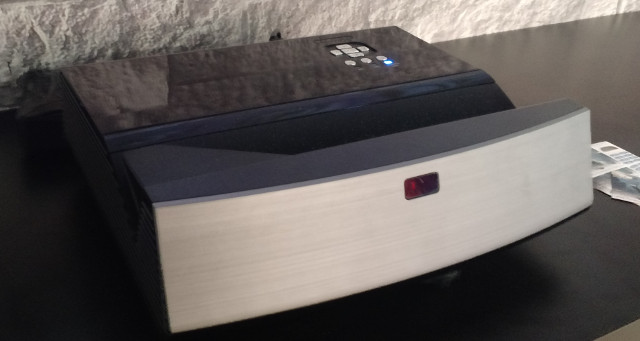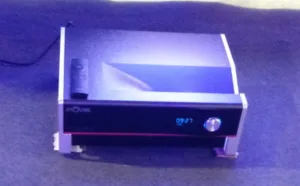Following Display Summit China, we told you that there was tremendous activity in China over the so-called “Laser TV” category. This means a laser-phosphor-based projector that is mounted below a screen and placed usually within 12-18 inches (30-45cm) from the 100-inch (2.5m) or so screen. Such a set up works well for a home TV or in commercial or educational applications. Performance on these systems can be very good especially with a wide color gamut from the phosphor source and a good light rejecting screen. Images look bright, colorful and contrasty. Below is a summary of examples we saw at InfoComm.
China-based Jiangsu Yita Material Technology started out as a lamp manufacturer and has now expanded into making projectors. Their more English-sounding name is Lampsi, but the laser TV projector is sold under the brand name of Inovel. We saw this projector in action at Display Summit China where it was used to display the conference agenda. The initial impression of the image is quite favorable, but closer inspection reveals that the lower left corner of the image is out of focus. This is probably the result of the projection optics design, which can be quite tricky to produce with high quality.
At InfoComm, the images were projected on an Elite screen. This projector has a lumen rating of around 3000 lumens and uses a 1080p DLP chip set. The company has just set up a new distributor in Whitney, NJ and is focused on selling this in the B2B, not consumer market to start. The projector sells for $3,500 and can be combined with the screen for $5,000. The light source is rated for a 20K hour lifetime (to 50% of brightness).
Coming by the end of the year is expected to be a 4K resolution model using the new DLP chip set with the 4 million pixel DLP chip and an image shifter device.
The company says pricing is still too high. Their sales volume for these projectors in 2016 is expected to only be 10-15K, but part of their sales pitch is that light reflected from a screen is easier on the eyes and less fatiguing than direct view displays.
JmGO is offering the S1 projector that features 3500 lumens, 1920×1080 resolution and a throw ratio of 0.25. This was shown as a non-working model in the TI booth at InfoComm. They claim it can create an image from 50” (at a distance of 0.3 meters) to 180 inches (at a distance of 1.7 meters.) One interesting feature is an intelligent eye sensor. This detects when someone or something is close and it lowers the brightness to ensure safety. Lifetime is speced at 30K hours, higher than most who spec it at 20K hours. The design is also quite different and is supposed to be inspired by fish, a traditional Chinese cultural symbol.

It is powered by an Mstar 64-bit quad processor and supports decoding of H.264, H.265 and VP9 including 4K/60 fps content. The color gamut is specified at 97% of Rec. 709 and it is 3D capable. With HDMI 2.0 support, 802.11 b/n/ac built in, and a 12.8 Gbps data transfer rate, this engine seems ready to support 4K DLP chips as well. Don’t be surprised to see a 4K version by the end of the year.
The unit appears to not be shipping yet as the web site is accepting deposits. The price is 16,999 yuan or about $2,582. We suspect the company is thinking about US distribution as well.
Optoma was in their own booth, in the Coretronics suite and in the TI booth showing off their laser phosphor ultra short throw projector. They call their product a “laser cinema”. It offers 3000 lumens, 1080p resolution and very short throw ratio of 0.18.

Appotronics is a clear leader in the laser phosphor space with a range of projectors including light sources for cinema-class models. Approtronics claims to have been the first to develop a 100” Laser TV back in January 2013, followed by the world’s first laser cinema projector in June 2014 and the first laser portable projector in October 2015.
It has released multiple versions of the short throw Laser platform in China and is now looking for distribution in Europe and North America. Nine models are offered with light outputs of 3200 (XGA and WXGA), 3600(XGA and WXGA), 4200 (XGA, WXGA, 1920×720, 1920×1080) and 6000 lumens (1920×1080). All feature 35,000:1 dynamic contrast, >85% uniformity and Rec. 709 color gamut. The 4:3 XGA models have a throw ratio of 0.297 while the 16:10, 16:9 and the 16:6 (1920×720) models has a throw ratio of 0.233. Lifetime is speced at 20K hours in normal mode. Only the 1920×1080 models are offered in black, while other models are offered in white.

Their laser phosphor engine is called ALPD and includes over 1000 related patents. Curiously, they are very nervous about losing control of their technology in China and so keep a tight lid on it, doing all manufacturing in-house Shenzhen.
Seemile is another Jiangsu province-based projector maker with a laser phosphor short throw projector. We visited their facility as part of the Display Summit China event last May (Seemile Shows Range of Projection Products on Plant Tour). They offer a range of laser-phosphor projectors with four ultra short throw models. These include WXGA models with 2500 and 4000 lumens and FHD models with 2300 and 3600 lumens. All have a throw ratio of 0.25 and source lifetime of 15K hours in normal mode. Contrast is specified at 10,000:1 and color gamut at more than90% of Rec. 709. All have dual RGBY color wheels.

A new fifth model uses the FHD DLP chip but achieve 100% of Rec. 709 and 3000 lumens of light output. Compared to the 2300 lumen, 90% of Rec. 709 model, power consumption increases from 240W to 450W, so wall plug efficiency drops dramatically from 8.6 lm/W to 6.0 lm/W. The higher lumen models feature a new light engine (that was profiled at Display Summit China).
Overall, Seemile says it is producing about 40K projectors per year and about 7K/year for the ultra short throws. Today, they say their 3000 lm FHD model sells for about 30,000 yuan (~$4,550), but their goal is to reach 10,000 RMB (~$1500) for the projector. – CC

